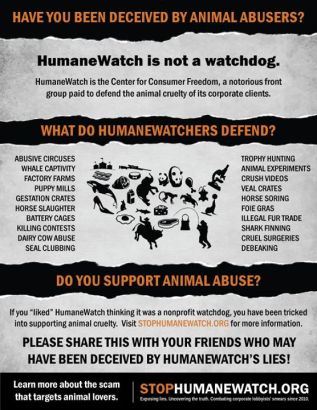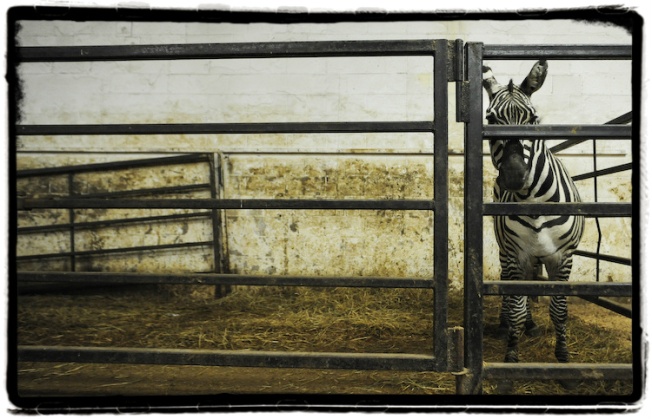 Written by: Heather Clemenceau
Written by: Heather Clemenceau
Artwork in support of Animals in the Anthropocene, by We Animals Media, Jo-Anne McArthur, and Keith Wilson.
There’s no doubt that, in the defence of animal agriculture, Canadian legislators and politicians are becoming more and more oppressive. They’d have us live in a place where we all wear blindfolds. Bill 156 has outlawed picketing, protests, and any watering of animals that interacts with animal transport. It has empowered farmers to arrest anyone on their premises, using a degree of force that is vague and undefined. To that end, Bill 156 is designed, in part, to make sure nobody will be acquitted under the “thirsty pig defence” in future.
Whistleblowers make disclosures that are in the public interest. They should be applauded, not punished. Thank you to everyone who has put their life on the line in the defence of animals.
Please know what MPPs voted for this legislation. Their emails and party affiliation are included. Most “aye” votes were registered by the PC Party, while most “nayes” were recorded by the NDP.
“Having unannounced inspections and external monitoring on large commercial farms would seem to be the right way forward to increase safety and public confidence – and that is the legislation that should be pushed forward.” ~ Jan Hajek is an infectious diseases doctor, who has worked in Ontario for SARS, in Newfoundland in 2009 for H1N1, in Sierra Leone for Ebola, and is now working on the COVID-19 ward at Vancouver General Hospital.
AYES / POUR – 68 (65 PC/3 Liberal)
Anand – Mississauga—Malton – deepak.anand@pc.ola.org
Baber – York Centre – roman.baber@pc.ola.org
Babikian – Scarborough—Agincourt – aris.babikian@pc.ola.org
Bailey – Sarnia—Lambton – bob.bailey@pc.ola.org
Barrett – Haldimand—Norfolk – toby.barrett@pc.ola.org
Bethlenfalvy -Pickering—Uxbridge – peter.bethlenfalvy@pc.ola.org
Blais – Orléans – sblais.mpp.co@liberal.ola.org
Bouma – Brantford—Brant – will.bouma@pc.ola.org
Calandra – Markham—Stouffville – paul.calandra@pc.ola.org
Cho – Willowdale – stan.cho@pc.ola.org
Clark – Leeds—Grenville—Thousand Islands and Rideau Lakes – steve.clark@pc.ola.org
Coe – Whitby – lorne.coe@pc.ola.org
Crawford – Oakville – stephen.crawford@pc.ola.org
Cuzzeto – Mississauga—Lakeshore – rudy.cuzzetto@pc.ola.org
Downey – Barrie—Springwater—Oro-Medonte – doug.downey@pc.ola.org
Dunlop – Simcoe North – jill.dunlop@pc.ola.org
Elliott– Newmarket—Aurora – christine.elliott@pc.ola.org
Fedeli – Nipissing – vic.fedeli@pc.ola.org
Fee – Kitchener South—Hespeler – amy.fee@pc.ola.org
Fraser – Ottawa South – Jfraser.mpp.co@liberal.ola.org
Fullerton – Kanata—Carleton – merrilee.fullerton@pc.ola.org
Ghamari – Carleton – goldie.ghamari@pc.ola.org
Gill – Milton – parm.gill@pc.ola.org
Harris – Kitchener—Conestoga – mike.harris@pc.ola.org
Hogarth – Etobicoke—Lakeshore – christine.hogarth@pc.ola.org
Jones – Dufferin—Caledon – sylvia.jones@pc.ola.org
Karahalios – Cambridge – belinda.karahalios@pc.ola.org
Ke – Don Valley North – vincent.ke@pc.ola.org
Khanjin – Barrie—Innisfil – andrea.khanjin@pc.ola.org
Kramp – Hastings—Lennox and Addington – daryl.kramp@pc.ola.org
Kusendova – Mississauga Centre – natalia.kusendova@pc.ola.org
MacLeod – Nepean – Lisa.macleodco@pc.ola.org
Martin – Eglinton—Lawrence – robin.martin@pc.ola.org
Martow – Thornhill – gila.martow@pc.ola.org
McDonell – Stormont—Dundas—South Glengarry – jim.mcdonell@pc.ola.org
McKenna – Burlington – jane.mckenna@pc.ola.org
McNaughton – Lambton—Kent—Middlesex – monte.mcnaughtonco@pc.ola.org
Miller – Parry Sound—Muskoka – norm.miller@pc.ola.org
Mitas – Scarborough Centre – christina.mitas@pc.ola.org
Mulroney – York—Simcoe – caroline.mulroney@pc.ola.org
Nicholls – Chatham-Kent—Leamington – rick.nicholls@pc.ola.org
Oosterhoff – Niagara West – sam.oosterhoff@pc.ola.org
Pang – Markham—Unionville – billy.pang@pc.ola.org
Park – Durham – lindsey.park@pc.ola.org
Parsa – Aurora—Oak Ridges—Richmond Hill – michael.parsaco@pc.ola.org
Pettapiece – Perth—Wellington – randy.pettapiece@pc.ola.org
Phillips – Ajax – rod.phillips@pc.ola.org
Piccini – Northumberland—Peterborough South – david.piccini@pc.ola.org
Rasheed – Mississauga East—Cooksville – kaleed.rasheed@pc.ola.org
Roberts – Ottawa West—Nepean – jeremy.roberts@pc.ola.org
Romano – Sault Ste. Marie – ross.romano@pc.ola.org
Sabawy – Mississauga—Erin Mills – sheref.sabawy@pc.ola.org
Sandhu – Brampton West – amarjot.sandhu@pc.ola.org
Scott – Haliburton—Kawartha Lakes—Brock – laurie.scott@pc.ola.org
Simard – Glengarry—Prescott—Russell – asimard.mpp@liberal.ola.org
Skelly – Flamborough—Glanbrook – donna.skelly@pc.ola.org
Smith – Bay of Quinte – todd.smithco@pc.ola.org
Smith – Peterborough—Kawartha – dave.smith@pc.ola.org
Surma – Etobicoke Centre – kinga.surma@pc.ola.org
Tangri – Mississauga—Streetsville – nina.tangri@pc.ola.org
Thanigasalam – Scarborough—Rouge Park – vijay.thanigasalam@pc.ola.org
Thompson – Huron—Bruce – lisa.thompson@pc.ola.org
Tibollo – Vaughan—Woodbridge – michael.tibollo@pc.ola.org
Triantafilopoulos – Oakville North—Burlington – effie.triantafilopoulos@pc.ola.org
Wai – Richmond Hill – daisy.wai@pc.ola.org
Walker – Bruce—Grey—Owen Sound – bill.walker@pc.ola.org
Yakabuski – Renfrew—Nipissing—Pembroke – john.yakabuski@pc.ola.org
Yurek – Elgin—Middlesex—London – jeff.yurek@pc.ola.org
NAYS / CONTRE – 22 (21 NDP/1 PC)
Arthur – Kingston and the Islands – IArthur-QP@ndp.on.ca
Begum – Scarborough Southwest – DBegum-QP@ndp.on.ca
Bell – University—Rosedale – JBell-QP@ndp.on.ca
Berns-McGown – Beaches—East York – RBerns-McGown-QP@ndp.on.ca
Bisson – Timmons – gbisson@ndp.on.ca
Bourgouin – Mushkegowuk—James Bay – GBourgouin-QP@ndp.on.ca
Fife – Waterloo – cfife-qp@ndp.on.ca
Glover – Spadina—Fort York – CGlover-CO@ndp.on.ca
Hassan – York South—Weston – FHassan-QP@ndp.on.ca
Hatfield – Windsor—Tecumseh – PHatfield-QP@ndp.on.ca
Horwath – Hamilton Centre – horwatha-qp@ndp.on.ca
Karpoche – Parkdale—High Park – BKarpoche-QP@ndp.on.ca
Kernaghan – London North Centre – TKernaghan-QP@ndp.on.ca
Mantha – Algoma—Manitoulin – mmantha-qp@ndp.on.ca
Rakocevic – Humber River—Black Creek – TRakocevic-QP@ndp.on.ca
Schreiner – Guelph – Mschreiner@ola.org
Stevens – St. Catharines – JStevens-QP@ndp.on.ca
Stiles – Davenport – MStiles-QP@ndp.on.ca
Taylor – Hamilton Mountain – mtaylor-qp@ndp.on.ca
Vanthof – Timiskaming—Cochrane – jvanthof-qp@ndp.on.ca
West – Sudbury – JWest-QP@ndp.on.ca
Yarde – Brampton North – KYarde-QP@ndp.on.ca
 Written by: Heather Clemenceau
Written by: Heather Clemenceau findings, and consumer complaints.
findings, and consumer complaints.  I hope our food scientists will continue to bring attention to serious risks in the food supply, rather than trying to pick off the “low-hanging fruit” that are the protests at slaughterhouses. I would like to propose that Dr. Warriner write an article condemning the abuse of transport and the risks of veterinary drug contamination with horse slaughter in Canada. Certainly horse slaughter is not a closed system – non-farmers are dealing in drugged meat with false and incomplete EIDs, concealing incompetence and deceit, often at the highest levels. In fact, I plan to send him an email asking him to do exactly that.
I hope our food scientists will continue to bring attention to serious risks in the food supply, rather than trying to pick off the “low-hanging fruit” that are the protests at slaughterhouses. I would like to propose that Dr. Warriner write an article condemning the abuse of transport and the risks of veterinary drug contamination with horse slaughter in Canada. Certainly horse slaughter is not a closed system – non-farmers are dealing in drugged meat with false and incomplete EIDs, concealing incompetence and deceit, often at the highest levels. In fact, I plan to send him an email asking him to do exactly that.








































































